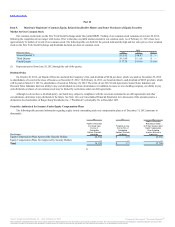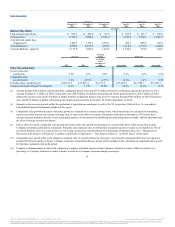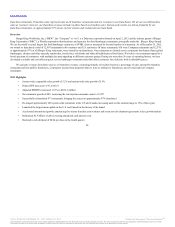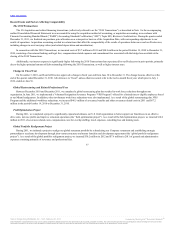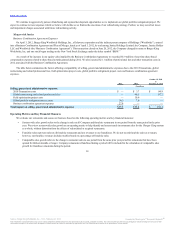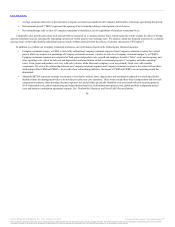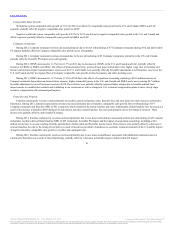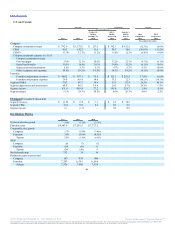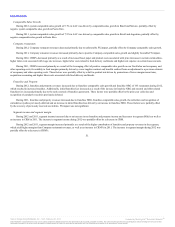Burger King 2012 Annual Report Download - page 42
Download and view the complete annual report
Please find page 42 of the 2012 Burger King annual report below. You can navigate through the pages in the report by either clicking on the pages listed below, or by using the keyword search tool below to find specific information within the annual report.
Table of Contents
Worldwide system comparable sales growth of 3.2% for 2012 was driven by comparable sales growth in the U.S. and Canada, EMEA and LAC
segments, partially offset by negative comparable sales growth in APAC.
Negative worldwide system comparable sales growth of 0.5% for 2011 was driven by negative comparable sales growth in the U.S. and Canada and
APAC segments, partially offset by comparable sales growth in EMEA and LAC.
During 2012, Company restaurant revenues decreased primarily due to the net refranchising of 871 Company restaurants during 2012 and unfavorable
FX impact, partially offset by Company comparable sales growth across all segments.
During 2011, Company restaurant revenues decreased due to the net refranchising of 45 Company restaurants, primarily in the U.S. and Canada,
partially offset by favorable FX impact across all segments.
During 2012, CRM% decreased to 11.3% from 11.7% in 2011 due to decreases in CRM% in the U.S. and Canada and LAC, partially offset by
increases in CRM% in EMEA and APAC. The effects of promotional activity, increased food, paper and product costs, higher wage rates in Germany and
Mexico and increased repair and maintenance expenses in the U.S. and Canada were partially offset by favorable adjustments to self insurance reserves in the
U.S. and Canada and the leveraging effect of Company comparable sales growth on fixed occupancy and other operating costs.
During 2011, CRM% decreased to 11.7% from 11.9% in 2010 due to the effects of acquisition accounting, including a $14.6 million increase in
Company restaurant depreciation and amortization expense, higher commodity prices in the U.S. and Canada and EMEA and a non-recurring $4.7 million
favorable adjustment to our self insurance reserve in 2010. These factors were partially offset by improved labor margins due to benefits realized from
improvements in variable labor controls and scheduling in our restaurants as well as changes in U.S. restaurant compensation plans to more closely align
incentive compensation with restaurant performance.
Franchise and property revenues consist primarily of royalties earned on franchise sales, franchise fees and rents from real estate leased or subleased to
franchisees. During 2012, franchise and property revenues increased primarily due to franchise comparable sales growth, the net refranchising of 871
Company restaurants and franchise NRG of 491 restaurants, which resulted in increased royalties and rents. Additionally, initial franchise fees increased as a
result of the increase in franchise NRG during 2012 and renewal and other related franchise fees increased primarily due to the timing of renewals. These
factors were partially offset by unfavorable FX impact.
During 2011, franchise and property revenues increased primarily due to new leases and subleases associated with the net refranchising of 45 Company
restaurants, royalties derived from franchise NRG of 265 restaurants, favorable FX impact and the impact of acquisition accounting, including a $6.6
million net increase in revenue resulting from the amortization of unfavorable and favorable income leases. These factors were partially offset by a decrease in
renewal franchise fees due to the timing of renewals as a result of incentives provided to franchisees to accelerate restaurant remodels in the U.S and the impact
of negative franchise comparable sales growth on royalties and contingent rents.
During 2012, franchise and property expenses increased primarily due to new leases and subleases associated with additional restaurants leased or
subleased to franchisees as a result of the refranchisings, partially offset by a decrease in bad debt expense and favorable FX impact.
41
Source: Burger King Worldwide, Inc., 10-K, February 22, 2013 Powered by Morningstar® Document Research℠
The information contained herein may not be copied, adapted or distributed and is not warranted to be accurate, complete or timely. The user assumes all risks for any damages or losses arising from any use of this
information, except to the extent such damages or losses cannot be limited or excluded by applicable law. Past financial performance is no guarantee of future results.


